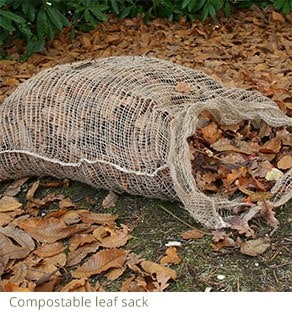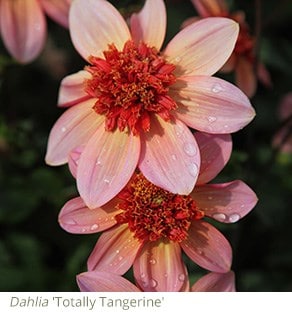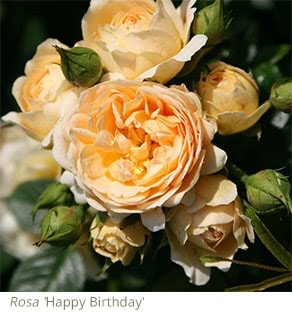November’s surely the dreariest month of the gardening year and there will be plenty of days when you can’t get out in your garden. The answer’s simple: bring a bit of the garden indoors by using some house plants. If you’re confined to the house, or you haven’t got a garden, a house plant is a great addition because they’ll cheer you up on the dullest of days with their lush foliage or bright flowers.

Cleaner Air
House plants not only soothe the mind, they freshen the air because they absorb carbon dioxide and emit oxygen. They will also remove particulates so they are often used in poorly ventilated spaces such as offices. Among the best ‘purifiers’ are the Dragon plant (Dracaena marginata), the Peace lily (Spathiphyllum wallisii), Devil’s ivy (Epipremnum aureum), mother-in-law’s tongue (Sansevieria trifasciata), the Bamboo Palm (Rhapis excelsa), the Flamingo lily (Anthurium spp), English ivy (Hedera helix) and the Weeping fig (Ficus benjamina).
A Touch of the Tropics
Foliage plants are bang on trend at the moment and some of the most interesting ones, with large handsome leaves, come straight from the jungle so they’re quite happy in light shade. However they do require constant warm temperatures, between 15 – 18C generally. They enjoy humidity too, because they’ve evolved in a steamy warm jungle where daily rain falls. Stand them on a bowl of ornamental pebbles and add water to the tray to create rising damp air. Then you’ll do well with Alocasia × amazonica 'Polly', an Elephant’s ear with dark green leaves ribbed in almost white. If happy, the underground rhizomes will begin to travel so a larger pot may be needed in time.
Elephant’s ear is not an easy plant to keep long term, but you can get the same sort of frosted foliage from a much easier house plant commonly called the Chinese evergreen (Aglaonema 'Jubilee Compacta'). This needs bright light to develop the interesting foliage, but not full sun, and this is a general rule for most foliage plants. The easy going, green oval foliage is whorled in pale sage-green and it fountains out from a tight base as it’s a foot high plant suitable for the smallest room. If you want a plant for the loo, go for foliage because the light is often subdued by frosted glass.
 You have to think ‘steamy jungle’ for Goeppertia veitchiana 'Medaillon', also known and sometimes sold under the name of Calathea. The dark green foliage of ‘Medaillon’ is feathered in cream and sage-green and the whole dark green leaf is encased in a bright green rim so the common name of Zebra plant is highly suitable. Goeppertia zebrina has almost lime-green foliage brush stroked in darker green, and G. ornata has dark foliage with finely feathered, ivory-white lines. The Eternal Flame, ‘Tassmania’ produces cockades of orange flowers above purplish green foliage and this makes the perfect gift because it can be sent out in a wooden crate. Or you could try the Lipstick plant (Aeschynanthus 'Twister XL'), a curious angular plant with bright red flowers and chain link foliage. The Flamingo flower, (Anthurium RED CHAMPION) provides another tropical red and green contrast and this needs water little and often. Any colourful tropical looking plant is likely to have vivid red or orange flowers and it will need a space on its own to shine. You have to think ‘steamy jungle’ for Goeppertia veitchiana 'Medaillon', also known and sometimes sold under the name of Calathea. The dark green foliage of ‘Medaillon’ is feathered in cream and sage-green and the whole dark green leaf is encased in a bright green rim so the common name of Zebra plant is highly suitable. Goeppertia zebrina has almost lime-green foliage brush stroked in darker green, and G. ornata has dark foliage with finely feathered, ivory-white lines. The Eternal Flame, ‘Tassmania’ produces cockades of orange flowers above purplish green foliage and this makes the perfect gift because it can be sent out in a wooden crate. Or you could try the Lipstick plant (Aeschynanthus 'Twister XL'), a curious angular plant with bright red flowers and chain link foliage. The Flamingo flower, (Anthurium RED CHAMPION) provides another tropical red and green contrast and this needs water little and often. Any colourful tropical looking plant is likely to have vivid red or orange flowers and it will need a space on its own to shine.
If you need an architectural plant to fill a bare corner the Madagascan dragon tree, or Dracaena, is easy to keep and slow growing. Give them bright conditions and normal room temperatures, preferably not lower that 14C. Water them sparingly in winter, keeping the compost on the dry side. Dracaena fragrans 'Lemon Lime' has green, cream and lime foliage and ‘White Jewel’ has subtly stripy cream and green foliage. ‘Marginata’ has a pink edge and a hint of white to the brighter green foliage.
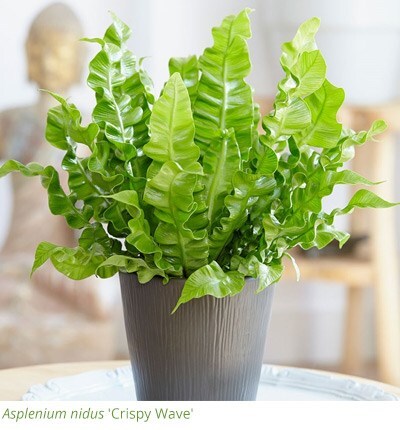
Ferny and Fabulous
Ferny foliage, in a simple pot, always looks fresh and feminine and it makes a simple statement for subdued light. Maidenhair ferns (Adiantum) have delicate lacy fronds and the critical thing is to give maidenehair ferns moisture – enough to keep the compost moist all through the year. Adiantum raddianum ‘Fragrantissimum' has wiry black stems and these offer a contrast to the bright green foliage. Or you could go grow the finely divided Asparagus fern (Asparagus densiflorus Sprengeri Group), for its almost spidery foliage. Other ferny creations include the Bird’s nest fern, Asplenium nidus 'Crispy Wave' which has tongue shaped slightly wavy edged bright green leaves. The Boston fern (Nephrolepis exaltata), which has neat fronds that looks as though they came straight from a woodland glade, is another option. These finely divided ferns love a moist spray of water and, if you feed them, always use a weak concentration.
Add a Touch of Victoriana
The Victorians loved house plants, especially toughies, and the well named Cast iron plant (Aspidistra elatior) was once found in very living room. Cast iron is a good description because this plant can thrive on neglect. Give them good light and wipe their leaves with a damp cloth to keep them looking handsome. Mother-in-law's tongue or the Snake plant (Sansevieria zeylanica), is another indestructible plant and this will thrive in shade. The jagged upright foliage of this agave relative usually rises vertically, although there are more prostrate forms such as Sansevieria kirkii 'Silver Blue'. Another Victorian favourite is a fern look alike named mind-your-own-business (Soleirolia soleirolii). It produces a mound of tiny leaves and part of its charm is the way it cascades over a pot.
Dual purpose house plants
Cacti and succulents make great house plants and, in the summer, they can be moved outside into a bright position with a little protect (initially at least) from full midday sun. Find them a bright windowsill and water them from the bottom once the pot is dry. Don’t keep the compost damp all the time. Succulents, such as Echeverias, should have their flower stalks removed before they set seeds because some die back if the pods are left. Echeverias produce clusters of rosettes that come in rose-pink or grey-green, and you can also move air plants outside in summer.
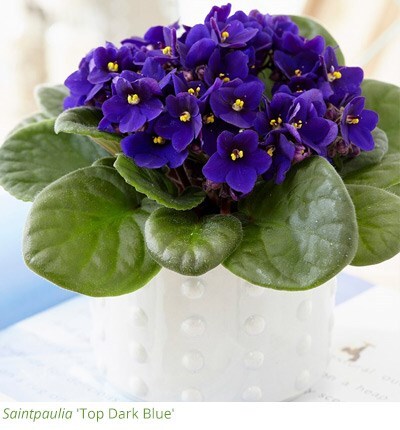
North facingThe classic plant for a north facing cool windowsill is the elegant Streptocarpus, or Cape primrose. These need average warmth (13C) to flower well and they benefit from being stood on wet pebbles or similar because dry air browns the foliage. They tend to flower in early spring and the flowers need to be removed, to promote more. Let the compost dry a little between watering.
If you can offer more light but not direct sunlight, the African violet, or Saintpaulia, should perform well for you. Pull of any fading leaves and flowers because these may cause the middle to rot away if left, and water from the bottom once the compost begins to dry out. I don’t think you can beat a strong blue such as ‘Top Dark Blue’.
Watering is Crucial
Most house plants die from being overwatered, literally killed with kindness, and generally most need less water in winter because transpiration (water loss from the foliage) slows down. Try to use soft water from a water butt, but if this isn’t available, leave a can or jug of water to stand for a couple of hours so that any chlorine escapes. The best way to tell if a house plant needs watering is to plunge the tip of your index finger into the compost. If it feels damp, don’t water. The weight of the pot is also a good indicator once you get to know how the pot feels in your hand.
Feeding and tidying
You won't need to feed your house plant throughout the winter, but to keep it looking tiptop, you will need to feed it regularly from spring to autumn. Baby bio drip feeders are easy to use. Your plants will also benefit from a regular tidy up, so snip off any shabby foliage or spent flowers and shine up the leaves if they’re high-gloss and leathery.
|









